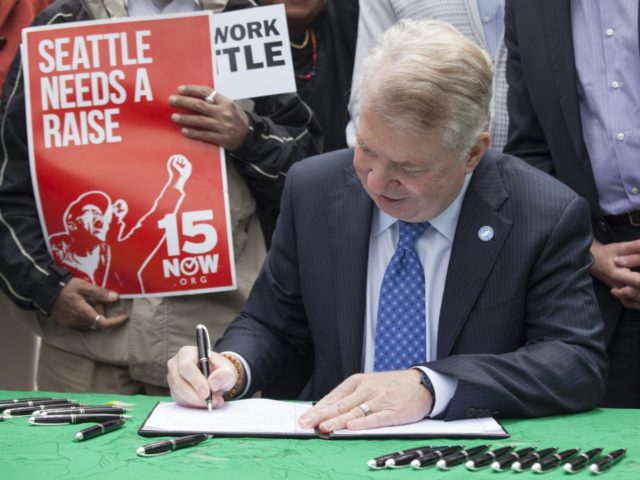A Seattle-sponsored analysis of the city’s $3 per hour minimum wage hike has found that it cost the average low-skilled worker $1,500 a year due to employers slashing hours.
Liberal Seattle City Councilpersons were so sure that the “$15 For All” minimum wage hike would lift the poor out of poverty and cut government welfare spending that they contracted with the University of Washington’s Evans School of Public Policy & Governance to evaluate each of the three-phase minimum wage increases. The increases began with a base of $9.32 per hour in 2014; to $11 in April 2015; to $13 in 2016; and $15 in 2017 (small firms with under 500 employees were given an extra year for each bump).
The supposedly humanitarian initiative was “justified” as good public policy based on an Employment Policy Institute analysis that claimed each $1 increase for the minimum wage would shrink government welfare spending by $155 a month. That claim was based on the “means-testing” requirements of the Earned Income Tax Credit, the refundable portion of the Child Tax Credit; the SNAP food stamp program; the Low Income Home Energy Assistance Program; the Supplemental Nutrition Program for Women, Infants, and Children; the Section 8 Housing Choice Voucher program; Medicaid; and the Temporary Assistance for Needy Families program cash assistance programs.
Breitbart News reported that the California and New York, plus dozens of cities nationwide, passed $15 minimum wage laws over the next two years. The Democrat Party incorporated the Service Employees International Union’s Fight For $15 into its 2016 national platform, claiming that raising minimum wages would cut $1 trillion in federal, state and local government welfare costs.
In 2015, a study by the University of California Berkeley’s Institute for Research and Employment called the first phase of Seattle’s minimum wage hike, to $11 an hour, a success. The study found that despite conservatives warning that higher costs would cut jobs, Seattle’s employment rose.
But Breitbart News reported in August that Moody’s Credit Service as cautioned, “Simply showing that Seattle added jobs after the minimum wage hike does not disprove job losses.” Moody’s questioned what would have happened without the 20 percent increase.
Shortly thereafter, the University of Washington’s Jacob Vigdor reported that in a cost-benefit-analysis for the 2015 hike to $11 an hour, “the effects of dis-employment appear to be roughly offsetting the gain in hourly wage rates, leaving the earnings for the average low-wage worker unchanged.” UW suggested that “negative unintended consequences” may rise as businesses and workers have more time to adapt to the minimum wage ordinance.
Now, UW has published its cost-benefit analysis of Seattle’s 2016 second-phase minimum wage increase to $13 per hour at the highly-respected National Bureau of Economic Research.
Although Vigdor reiterated that UW’s first-phase analysis of the $11 an hour minimum wage hike generated “fairly imprecise estimates,” he stated that the 2016 second-phase minimum wage hike cost the average low-skilled worker in Seattle $125 per month due to employers slashing 14 million hours of work.
UW found that the average low-wage employee enjoyed $54 per month in higher earnings due to the $3.53 per hour increase associated with the second phase of Seattle’s minimum wage ordinance. But Seattle’s low-wage workers lost $179 a month on average due to job losses and reductions in hours worked. That amounts to $1,500 a year.
The University of Washington study has made an important contribution to the economics literature regarding the dis-employment consequences of government interfering with setting wages. But the study also makes Seattle the poster of child how liberals can hurt the poor.

COMMENTS
Please let us know if you're having issues with commenting.